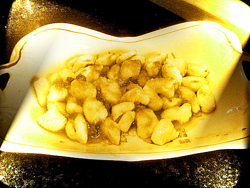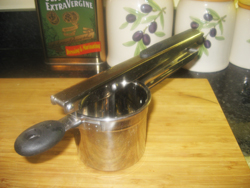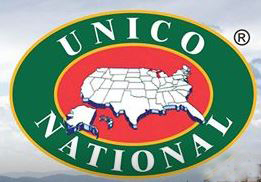 I know there are hundreds, maybe thousands of high profile dishes around the world whose correct pronunciation is possible only for native speakers of a language. However because “nokeys” seem to have become such a recurring featured item on the cooking shows and websites lately someone should blow the whistle.
I know there are hundreds, maybe thousands of high profile dishes around the world whose correct pronunciation is possible only for native speakers of a language. However because “nokeys” seem to have become such a recurring featured item on the cooking shows and websites lately someone should blow the whistle.
The spotlight of course is on the potato, and specifically an iteration that combines it with flour and other ingredients to yield a tender, elegant combination of flavors and texture that can stand alone as an appetizer, a main starch course or a side accompaniment for just about any meat, fish or fowl one can imagine.
We are talking about a multi-purpose vegetable that, like the tomato is a centuries-old export from South America thanks to our good friends the Conquistadores. The potato has since been embraced by cooks all over the world as if it were part of their cuisine and culture from time immemorial.
Now for the language lesson. The pronunciation is NEE-YAWKEY. Rhymes with Milwaukee, not “Okey Dokey. ” Actually you need to pause on the “k” before going on to the “ey.” The translation from Italian is “dumplings.” Generically in whatever language the term applies to a variety of pasta-like items that are steamed, boiled or even fried with or without potatoes in the formula. Chinese pot stickers or steamed dumplings come to mind for example. Hungarian spaetzle is another. Gnocchi di patate, the subject of this dissertation, to which you are now riveted since you’ve come this far, is a popular variety of potato dumpling most widely found in the cuisine of the provinces of Abbruzzi and Lazio in central Italy.
Watching the TV chefs make “nokey” would lead you to believe that this dish is a snap. And so it is. A dish that will snap your nerves to be precise. Friends, this is one of those delicacies that has a very low tolerance for error. They don’t tell you that on the TV shows. In the pharmaceutical business whence I came we would have called such examples “critical dose products.” That means too little of ingredient “x” results in no medical benefit and too much kills the patient. To make it worse the margin between too little and too much is tiny. In the case of nokeys the “x” factor is flour.
Let’s just say that after umpteen attempts I have settled on a formula that seems to work every time for me. It is actually one that appears in Lidia Bastianich’s outstanding volume entitled Lidia’s Italian Table (William Morrow & Co., New York, 1998, p. 175). This recipe specifies 3 large Idaho potatoes per 2 cups flour “or as needed.” I like that qualifier because invariably more flour is needed than specified in the recipes to render the dough manageable!
Now for some controvesy.
First there is the claim that the potatoes should be boiled skin-on until tender and then immediately peeled while hot with the aid of asbestos oven mitts and a paring knife. The Italian grandmas will testify under oath that this step is critical and cannot be compromised in any way. Both my grandmas followed this protocol burning their fingers from time to time in the process. Willing to be branded as a heretic I say the potatoes should be very, very warm when peeled but not necessarily scorching hot.
 Second, the question is whether to mash the cooked and peeled potatoes with a food mill vs. a potato ricer. Again the Italian grandmas will opt for the potato ricer, known to them as a “schiacciapatate,” pictured on the left, because it breaks down the potato more evenly and smoothly than the ham-handed food mill. Having done it both ways I proudly side with the grandmoms even if the proof of a difference is lacking. The food mill is really a clumsy tool for this application anyway. Next, I find that mixing the flour and potatoes after the riced potatoes reach room temperature is a better choice, having tried the recipe with cold riced potatoes and being disappointed with the result. TV chef Anne Burrell recommends exactly the opposite, claiming that chilled riced potatoes absorb less flour and result in a tenderer dumpling. The logic escapes me. The more water that evaporates out of the potatoes the less flour that can be absorbed. Chilling the stuff actually retards evaporation and keeps the unwanted moisture in place.
Second, the question is whether to mash the cooked and peeled potatoes with a food mill vs. a potato ricer. Again the Italian grandmas will opt for the potato ricer, known to them as a “schiacciapatate,” pictured on the left, because it breaks down the potato more evenly and smoothly than the ham-handed food mill. Having done it both ways I proudly side with the grandmoms even if the proof of a difference is lacking. The food mill is really a clumsy tool for this application anyway. Next, I find that mixing the flour and potatoes after the riced potatoes reach room temperature is a better choice, having tried the recipe with cold riced potatoes and being disappointed with the result. TV chef Anne Burrell recommends exactly the opposite, claiming that chilled riced potatoes absorb less flour and result in a tenderer dumpling. The logic escapes me. The more water that evaporates out of the potatoes the less flour that can be absorbed. Chilling the stuff actually retards evaporation and keeps the unwanted moisture in place.
Finally, there is the question of added ingredients. After consulting the Italian websites I can report that Lidia’s recipe, surprisingly, is not duplicated in the Italian references. The main discrepancies are nutmeg and parmesan cheese, both of which are included in Lidia’s recipe but neither of which, as far as I can tell, can be found in the Italian sources. Curiously Lidia’s web site recipe for gnocchi dough, unlike her book version, also fails to mention nutmeg or cheese.
My grandmother, the late Marietta DiDomenico, a card-carrying Abbruzzese, always included nutmeg but not the cheese in her recipe. I would say the matter is settled.
And so at last as a reward for your rapidly dwindling patience here the road-tested candidate for the winning recipe for “nokeys:”
Gnocchi di Patate
For 4 persons as a main dish or 6 as an appetizer or side:
-
Three large Idaho potatoes rinsed and scrubbed clean
-
1 or 2 large eggs (2 is my preference)
-
1 tsp. salt
-
1/4 tsp. ground black pepper
-
1 generous pinch grated whole nutmeg
-
1/4 cup imported parmesan cheese (not the item in the green can please)
-
2 cups unbleached all-purpose flour or “as needed” (thanks Lidia!)
Prep time: most of the morning or afternoon
Boil potatoes starting with cold water for about 35 minutes or bake in preheated 400 degree oven for 40 minutes. Stab the potatoes with a fork to evaluate doneness. Then remove potatoes and begin peeling. Lidia says “the hotter the potatoes are when they are peeled and riced the lighter the gnocchi will be.” As I said I’m not totally convinced. But certainly the warmer the better. Run peeled potatoes through a ricer. Lidia says the ricer makes for “fluffier potatoes.” Once again the ricer is best merely because it is easier to use. There is no evidence on the planet to back up the “fluffiness” claim.
Spread riced potatoes over the work surface and let cool. You want to give the potatoes some time to lose moisture by evaporation and also to avoid cooking the eggs when you add them. Gather potatoes into a mound and form a well in the center. Pour the eggs, nutmeg, salt and pepper into the well and mix with a fork. Then knead the potatoes, the flour and egg mixture and parmesan cheese together by hand and don’t be concerned if everything becomes sticky. (I however become concerned at this point and reach for a glass of Montepulciano d”Abbruzzo to steady my nerves).
After gathering the dough on the work surface set it aside and scrape the board clean. Then add a little additional flour and work the dough into a uniform round ball that is still a bit sticky but holds together. Cut off maybe one sixth of the dough and set the rest aside covered with a damp towel. With floured hands take the cut portion onto the work surface. Now begin your fearless attempt to roll it into a snake by moving your hands deftly from the center to the outside while rolling back and forth at the same time. If you wind up with what looks like a 1/2 or 3/4 inch diameter garden snake you’re on the right track! This is where I celebrate with a second glass of Montepulciano!
The rest is easy, sort of. Cut the snake into 1/2 or 3/4 inch lengths (I use a pastry scraper for this step). Make sure all pieces are lightly floured and not sticking together. Then you have two choices: You can simply move the pieces to a sheet pan dusted with corn meal to prevent sticking, and not touching one another, thus calling it quits or you can put on your Abbruzzese baseball cap and form authentic old world “nokeys!”
 You will do this by running the pieces over the tines of a fork with generously floured fingers thus forming the characteristic grooves you often find in the store-bought product. Or you can use a gnocchi board like the one pictured, thus forming not only grooves but a curled sea shell shape guaranteed to hold whatever sauce you put on it.
You will do this by running the pieces over the tines of a fork with generously floured fingers thus forming the characteristic grooves you often find in the store-bought product. Or you can use a gnocchi board like the one pictured, thus forming not only grooves but a curled sea shell shape guaranteed to hold whatever sauce you put on it.
The gnocchi can be frozen on a flat baking sheet that fits in the freezer and then once hardened, transferred to a zip lock for future use.
For serving boil gnocchi in salted water, and once they float to the top drain in a colander. If previously frozen there is no need to defrost before coooking. Serve immediately with marinara tomato sauce, meat sauce, parmesan cream sauce, bechamel or whatever other sauce you like with pasta dishes.
When all is done, if you get this right, you will never regret having run the gnocchi gauntlet!
After which you are entitled to yet another glass of Montepulciano.
 I’m talking about a pasta recipe contest sponsored by the Delaware chapter of a national Italian-American service organization called UNICO. And you would be correct, members are called “unicans”.
I’m talking about a pasta recipe contest sponsored by the Delaware chapter of a national Italian-American service organization called UNICO. And you would be correct, members are called “unicans”.
 I know there are hundreds, maybe thousands of high profile dishes around the world whose correct pronunciation is possible only for native speakers of a language. However because “nokeys” seem to have become such a recurring featured item on the cooking shows and websites lately someone should blow the whistle.
I know there are hundreds, maybe thousands of high profile dishes around the world whose correct pronunciation is possible only for native speakers of a language. However because “nokeys” seem to have become such a recurring featured item on the cooking shows and websites lately someone should blow the whistle. Second, the question is whether to mash the cooked and peeled potatoes with a food mill vs. a potato ricer. Again the Italian grandmas will opt for the potato ricer, known to them as a “schiacciapatate,” pictured on the left, because it breaks down the potato more evenly and smoothly than the ham-handed food mill. Having done it both ways I proudly side with the grandmoms even if the proof of a difference is lacking. The food mill is really a clumsy tool for this application anyway. Next, I find that mixing the flour and potatoes after the riced potatoes reach room temperature is a better choice, having tried the recipe with cold riced potatoes and being disappointed with the result. TV chef Anne Burrell recommends exactly the opposite, claiming that chilled riced potatoes absorb less flour and result in a tenderer dumpling. The logic escapes me. The more water that evaporates out of the potatoes the less flour that can be absorbed. Chilling the stuff actually retards evaporation and keeps the unwanted moisture in place.
Second, the question is whether to mash the cooked and peeled potatoes with a food mill vs. a potato ricer. Again the Italian grandmas will opt for the potato ricer, known to them as a “schiacciapatate,” pictured on the left, because it breaks down the potato more evenly and smoothly than the ham-handed food mill. Having done it both ways I proudly side with the grandmoms even if the proof of a difference is lacking. The food mill is really a clumsy tool for this application anyway. Next, I find that mixing the flour and potatoes after the riced potatoes reach room temperature is a better choice, having tried the recipe with cold riced potatoes and being disappointed with the result. TV chef Anne Burrell recommends exactly the opposite, claiming that chilled riced potatoes absorb less flour and result in a tenderer dumpling. The logic escapes me. The more water that evaporates out of the potatoes the less flour that can be absorbed. Chilling the stuff actually retards evaporation and keeps the unwanted moisture in place. You will do this by running the pieces over the tines of a fork with generously floured fingers thus forming the characteristic grooves you often find in the store-bought product. Or you can use a gnocchi board like the one pictured, thus forming not only grooves but a curled sea shell shape guaranteed to hold whatever sauce you put on it.
You will do this by running the pieces over the tines of a fork with generously floured fingers thus forming the characteristic grooves you often find in the store-bought product. Or you can use a gnocchi board like the one pictured, thus forming not only grooves but a curled sea shell shape guaranteed to hold whatever sauce you put on it.